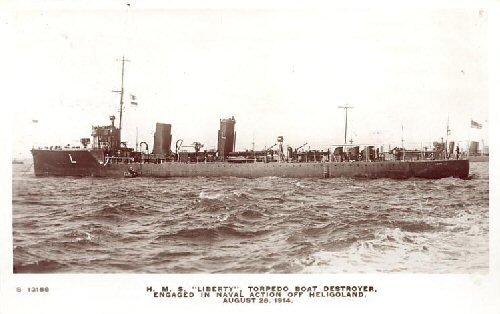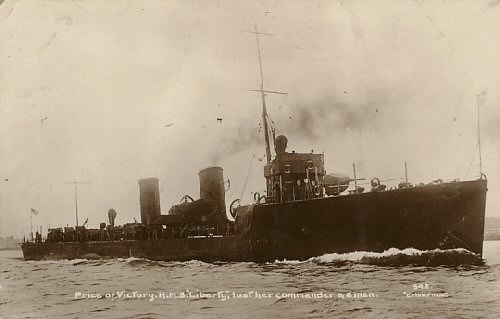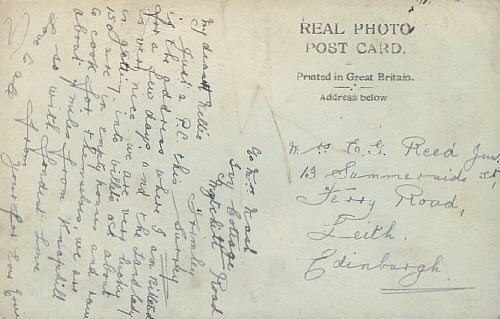
Sold for Scrap 5 November 1921
THE LAFOREY CLASS DESTROYER HMS LIBERTY.
HMS Liberty, built by White, launched as HMS ROSALIND 15/9/1913, renamed HMS LIBERTY, 30/9/1913. Sold for breaking up at Granton,5/11/1921.
Laforey Class Torpedo Boat Destroyers
These were the last Destroyers completed before the outbreak of world war One, and the first class to be named in the new Alphabetical system. Also six of the class were built with two funnels with the remainder having three. They were also the first class to be given double torpedo Tubes, and another first was that two destroyers of the class HMS Leonidas and HMS Laforey had geared turbines. The " L" Flotilla saw a lot of active service during the war. with HMS Lance having fired the first naval shot of the war when it sank (along with HMS Landrail) the German minelayer Konigen Luise they took part in most of the naval actions but only a few were The Battle of Jutland. During the war they formed the famous "Harwich force".
Despatch of Commodore Tyrwhitt:
Sir, I have the honour to report that at 5 a.m. on Thursday, 27th August, in accordance with orders received from their Lordships, I sailed Arethusa, in company with the first and Third flotillas, except, hornet, tigress, hydra and Loyal, to carry out the prearranged operations. HMS Fearless joined the flotillas at sea that afternoon.
At 6.53 a.m. on Friday, 28th August, an enemy's Destroyer was sighted, and was chased by the 4th Division of the Third flotilla.
From 7.20 to 7.57 a.m. Arethusa and the third Flotilla were engaged with numerous Destroyers and torpedo boats which were making for Heligoland; course was altered to port to cut them off.
Two Cruisers, with four and two funnels respectively, were sighted on the port bow at 7.57 a.m., the nearest of which was engaged. Arethusa received a heavy fire from both Cruisers and several Destroyers until 8.15 a.m., when the four-funnels Cruiser transferred her fire to Fearless.
Close action was continued with the two-funnelled Cruiser on converging courses until 8.15 a.m. when a 6-in. projectile from Arethusa wrecked the fore bridge of the enemy, who at once turned away in the direction of Heligoland, which was sighted slightly on the starboard bow about this time.
All ships were at once ordered to turn to the westward, and shortly afterwards speed was reduced to 20 knots.
During this action Arethusa had been hit many times, and was considerably damaged; only one 6-in. gun remained in action, all other guns and torpedo tubes having been temporarily disabled.
Lieutenant Eric E P Westmacott (Signal Officer) was killed at my side during the action. I cannot refrain from adding that he carried out his duties calmly and collectedly, and was of the greatest assistance to me.
A fire occurred opposite no. 2 gun, port side, caused by a shell exploding some ammunition, resulting in a terrific blaze for a short period and leaving the deck burning. This was very promptly dealt with and extinguished by chief Petty officer Frederick W Wrench, ON 158630.
The Flotillas were reformed in Divisions, and proceeded at 20 knots. It was now noticed that Arethusa's speed had been reduced.
Fearless reported that the 3rd and 5th Divisions of the First Flotilla had sunk the German Commodore's Destroyers, and that two boats' crews belonging to Defender had been left behind, as our Destroyers had been fired upon by a German Cruiser during their act of mercy in saving the survivors of the German Destroyer.
At 10 a.m., hearing that Commodore (S) in Lurcher and Firedrake was being chased by Light Cruisers, I proceeded to his assistance with Fearless and the First Flotilla until 10.37 a.m., when having received no news, and being in the vicinity of Heligoland, I ordered the ships in company to turn to the westward.
All guns except two 4-inch were again in working order, and the upper deck supply of ammunition was replenished.
At 10.55 a.m. a four-funnelled German Cruiser was sighted, and opened a very heavy fire at about 11 o'clock.
Our position being somewhat critical, I ordered Fearless to attack, and the First Flotilla to attack with torpedoes, which they proceeded to do with great spirit. the Cruiser at once turned away, disappeared in the haze, and evaded the attack.
About ten minutes later the same Cruiser appeared on our starboard quarter. opened fire on her with both 6-in. guns; Fearless also engaged her, and one Division of Destroyers attacked her with torpedoes without success.
The state of affairs and our position were then reported to the Admiral commanding Battle Cruiser Squadron.
We received a very severe and almost accurate fire from this Cruiser; salvo after salvo was falling between 10 and 30 yards short, but not a single shell struck; two torpedoes were also fired at us, being well directed but short.
The Cruiser was badly damaged by Arethusa's 6-inch guns and a splendidly directed fire from Fearless, and she shortly afterwards turned away in the direction of Heligoland.
Proceeded, and four minutes later sighted the three-funnelled Cruiser Mainz. she endured a heavy fire from Arethusa and Fearless and many Destroyers. after an action of approximately 25 minutes she was seen to be sinking by the head, her engines stopped, besides being on fire.
At this moment the Light Cruiser Squadron appeared, and then very speedily reduced the Mainz to a condition which must have been indescribable.
I then recalled Fearless and the destroyers, and ordered cease fire.
We then exchanged broadsides with a large, four-funnelled Cruiser on the starboard quarter, without visible effect.
The Battle Cruiser Squadron now arrived, and I pointed out this Cruiser to the Admiral commanding, and was shortly afterwards informed by him that the Cruiser in question had been sunk and another set on fire.
The weather during the day was fine, sea calm, but visibility poor, not more than 3 miles at any time when the various actions were taking place, and was such that ranging and spotting were rendered difficult.
I then proceeded with 14 Destroyers of the Third flotilla, and 9 of the First flotilla.
Arethusa's speed was about 6 knots until 7 p.m., when it was impossible to proceed any further, and fired were drawn in all boilers except two, and assistance called for.
At 9.30 Captain Wilmot S Nicholson, of the Hogue, took my ship in tow in a most seamanlike manner, and, observing that the night was pitch dark and the only lights showing were two small hand held lanterns, I consider his action was one which deserves special notice from Their Lordships.
I would also specially recommend Lieutenant-Commander Arthur P N Thorowgood, of Arethusa, for the able manner he prepared the ship for being towed in the dark.
HM ship under my command was then towed to the Nore, arriving at 5 p.m. on the 29th August. steam was then available for slow speed, and the ship was able to proceed to Chatham under her own steam.
I beg again to call attention to the services rendered by Captain W F Blunt, of HMS Fearless and the Commanding Officers of the Destroyers of the First and third Flotillas, whose gallant attacks on the German Cruisers at critical moments undoubtedly saved Arethusa from more severe punishment and possible capture.
I cannot adequately express my satisfaction and pride at the spirit and ardour of my Officers and Ship's Company, who carried out their orders with the greatest alacrity under the most trying conditions, especially in view of the fact that the ship, newly built, had not been 48 hours out of Dockyard before she was in action.
It is difficult to specially pick out individuals, but the following came under my special observation:-
The late Lieutenant-Commander Nigel K W Barttelot commanded the Liberty with great skill and gallantry throughout the action. He was a most promising and able officer, and I consider his death a great loss to the Navy.
Engineer Lieutenant-Commander Frank A butler, who showed much resource in affecting repairs during the action.
Lieutenant Henry e Horan, First Lieutenant, who took command after the death of Lieutenant-Commander Barttelot, and brought his ship out of action in an extremely able and gallant manner under the most trying conditions.
Mr Harry Morgan, Gunner (T), who carried out his duties with exceptional coolness under fire.
Chief Petty Officer James Samuel Beadle, ON 171735, who remained at his post at the wheel for over an hour after being wounded in the kidneys.
John Glavin, Stoker Petty officer, ON 279946, who took entire charge under the Engineering Officer, of the party who stopped leaks, and accomplished his task although working up to his chest in water.


